|
Location:
Lochmariaquer, Brittany, France. |
Grid Reference:
47� 35' 45.47" N. 3� 3' 13.57" W.
|
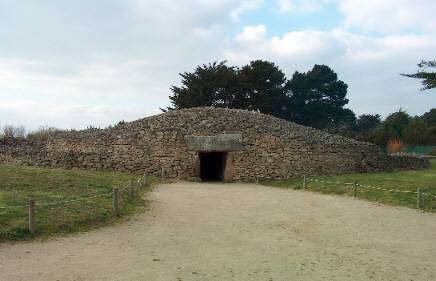
 La Table des Marchands:
(Passage Mound).
La Table des Marchands:
(Passage Mound).
This
passage-mound is
situated alongside the
Le Grand Menhir
Brise, and the
Er Grah
tumulus which combine together to form
the Lochmariaquer site.
It is dated at around 3,300 BC, and was orientated to the
mid-summer solstice, a feature unique to European passage mounds of the time
The capstone has been shown to have once been a part of a
larger stone, which is believed to have once stood alongside Le Grande
menhir Bris �
in an alignment of 19 stones.
(Map
with location of site)
| La
Table des Marchands: (The Merchants Table). |
The location of this neat little passage-mound betrays its obvious
importance. It was built only yards from Le Grand Menhir Bris�,
once the tallest menhir in Europe, and the centre stone for the great lunar
observatory at Carnac. The mound has been restored five times since 1811,
denying us the means of ever seeing it again in its original form, but it still
contains two huge engraved stones that reveal much about the builders of the
mound.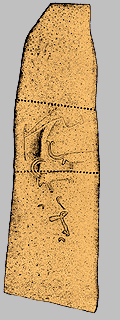
Firstly - The builders re-used stone from the
original construction at the site (radio-carbon dated at 4,500 BC). The capstone, and possibly the
'end-stone' are parts of larger menhirs that were already quarried, moved
and cut long before the mound was built. It is therefore probable that at
the time of construction (Approximately 3,000 BC), that the area had already
achieved recognition.
Secondly - The construction that proceeded
the Table des Marchands (See
Le Grand Menhir Bris�),
was designed to measure the lunar cycle, whereas the Table des Marchands is
orientated to the mid-summer sunrise (and
Gavrinis to the winter
solstice). This indicates a dramatic shift in thinking.
|
The re-use of masonry is a common thing, even
with such obviously important stone, but the fact that the stones were not
re-engraved tends to suggest that the engravings themselves may have had an importance
of their own. It is curious therefore that the engravings were left face
down and visible at La Table des Marchands, but were placed face-up and
therefore hidden at Gavrinis.
Excavations directed by J. L'Helgouac'h proved that the
end-stone was set in place before the dolmen itself was built.
In all likelihood, an open air stele (probably related to the
Grand-Menhir alignment) was strategically placed and the passage
grave built around it. (3)
The Capstone:
This capstone is said to measure 21ft
long, 12ft wide and is 6ft thick, and is estimated to weigh 40 tons
(2). The
capstone has been shown to be just a part of another, larger stone (above,
right), which was broken and re-used in at least three other sites.
Another part of the original stone was found to have been used for the
capstone of the
Gavr'inis
passage mound, where the
images were placed on the upper, hidden side of the stone, and yet another
part of the same stone was used for the capstone for the neighbouring
Er Grah tumulus
and a small piece from the top is now lost to us.



The engravings on this stone are continued
on the capstone at Gavrinis.
(More about the original construction at
Lochmariaquer and the lost stones)
The End-stone -
The supporting stone on the far wall of the chamber is also heavily carved. It is
this stone that receives the midsummer sunlight. This stone is sandstone,
the nearest source being 10km distant.
(3)
It is now believed to have been standing before the dolmen, passage and
mound were built over it.
(7)
This stone may well have been a part of the original construction,
standing at the end of the 19-stone alignment with Le
Grand menhir bris�
being the tallest stone at the site.
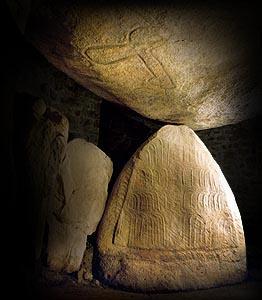
The huge 60 ton capstone rests on a mirror of
itself, now considered to have been an original feature from the earlier
phase dating back to 4,500 BC.

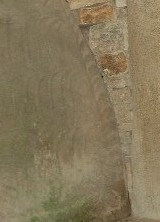
The exact
relevance of the 'shepherds crooks' on the centre face is unknown (The same shape
also appears frequently in Portuguese megaliths). However, the
56 crooks and the 19 crescents on the sides of this stone have led some to
speculate that they may represent a lunar count.
Chronology -
The construction of the dolmen, passage and mound was at around 3,900 to
3,800 BC, although it is suggested that the end-stone was already in place
before the dolmen and 'cairn' were constructed around it. the end-stone
itself dates back with the original construction (19-stone alignment) to
around 4,500 BC. The site has been used as a quarry by the Romans and
again over the ages until it was recorded bare in 1870 and only the dolmen
remained (see photo below).
Archaeo-astronomy
-
The chamber points in the
direction of the sunrise on midsummer's day. The large stone at the end of
the chamber is covered with symbols that have been variously interpreted.

Prof Muller of Germany
believes that 'The signs...refer to particular dates in the trajectory of
the moon and to eclipses of both the sun and moon'. He goes on to explain
'...I came across four sequences of numbers which revealed the calculations
behind the signs. They number 56; This number is found in
Stonehenge...known
as the Aubrey holes. In the two rows of lines ending in curves at Lochmariaquer, 29 can be counted pointing to the left and 27 pointing to the
right...In round numbers, 29 days are in fact the period which elapses
between two similar phases of the moon...called a moon lunation or a synodic
month. In a space of 27 days the moon returns to the same place in the
sky...(a sidereal month). This idea receives further confirmation if the
small semi-circles on the left hand side are counted. There are 19. This is
also a significant number as the moon takes 19 (18.6), years to go from one
end to the other'.
(1)
Gallery of Images.
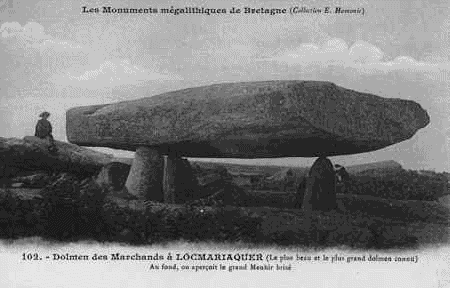
La Table des Marchands before the several fanciful restorations (The
monument was bare like this when it was purchased by the government in
1870). (4)
(Other French sites)
|









